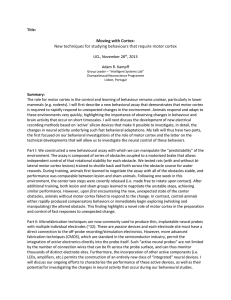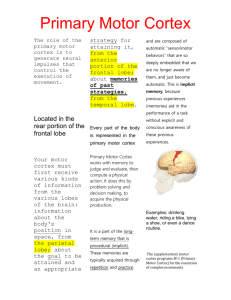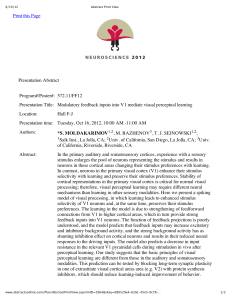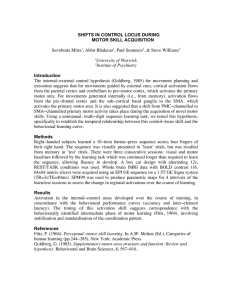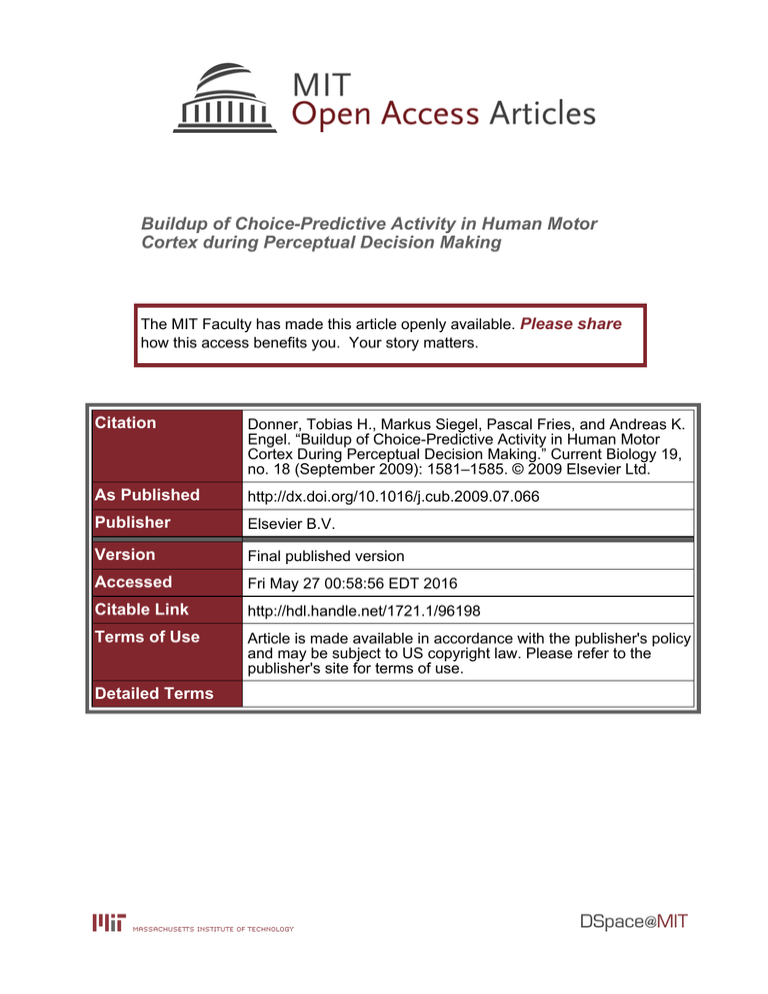
Buildup of Choice-Predictive Activity in Human Motor
Cortex during Perceptual Decision Making
The MIT Faculty has made this article openly available. Please share
how this access benefits you. Your story matters.
Citation
Donner, Tobias H., Markus Siegel, Pascal Fries, and Andreas K.
Engel. “Buildup of Choice-Predictive Activity in Human Motor
Cortex During Perceptual Decision Making.” Current Biology 19,
no. 18 (September 2009): 1581–1585. © 2009 Elsevier Ltd.
As Published
http://dx.doi.org/10.1016/j.cub.2009.07.066
Publisher
Elsevier B.V.
Version
Final published version
Accessed
Fri May 27 00:58:56 EDT 2016
Citable Link
http://hdl.handle.net/1721.1/96198
Terms of Use
Article is made available in accordance with the publisher's policy
and may be subject to US copyright law. Please refer to the
publisher's site for terms of use.
Detailed Terms
Current Biology 19, 1581–1585, September 29, 2009 ª2009 Elsevier Ltd All rights reserved
DOI 10.1016/j.cub.2009.07.066
Report
Buildup of Choice-Predictive Activity
in Human Motor Cortex
during Perceptual Decision Making
Tobias H. Donner,1,2,3,* Markus Siegel,1,3,4 Pascal Fries,3
and Andreas K. Engel1
1Department of Neurophysiology and Pathophysiology,
University Medical Center Hamburg-Eppendorf,
Martinistrasse 52, 20246 Hamburg, Germany
2Department of Psychology and Center for Neural Science,
New York University, 6 Washington Place, New York,
NY 10003, USA
3Donders Institute for Brain, Cognition and Behaviour,
Radboud University Nijmegen, Kapittelweg 29,
6525 EN Nijmegen, The Netherlands
4The Picower Institute for Learning and Memory, Department
of Brain and Cognitive Sciences, Massachusetts Institute of
Technology, 77 Massachusetts Avenue, Cambridge,
MA 02139, USA
Summary
Simple perceptual decisions are ideally suited for studying
the sensorimotor transformations underlying flexible
behavior [1, 2]. During perceptual detection, a noisy sensory
signal is converted into a behavioral report of the presence
or absence of a perceptual experience [3]. Here, we used
magnetoencephalography (MEG) to link the dynamics of
neural population activity in human motor cortex to perceptual choices in a ‘‘yes/no’’ visual motion detection task. We
found that (1) motor response-selective MEG activity in the
‘‘gamma’’ (64–100 Hz) and ‘‘beta’’ (12–36 Hz) frequency
ranges predicted subjects’ choices several seconds before
their overt manual response; (2) this choice-predictive
activity built up gradually during stimulus viewing toward
both ‘‘yes’’ and ‘‘no’’ choices; and (3) the choice-predictive
activity in motor cortex reflected the temporal integral of
gamma-band activity in motion-sensitive area MT during
stimulus viewing. Because gamma-band activity in MT
reflects visual motion strength [4], these findings suggest
that, during motion detection, motor plans for both ‘‘yes’’
and ‘‘no’’ choices result from continuously accumulating
sensory evidence. We conclude that frequency-specific
neural population activity at the cortical output stage of
sensorimotor pathways provides a window into the mechanisms underlying perceptual decisions.
Results
During flexible sensory-guided behavior, our brain maps interpretations of sensory information onto complex courses of
action. A simple example is perceptual detection, in which
a noisy sensory signal is converted into an arbitrary behavioral
response (e.g., a verbal report or button press) indicating our
sensory experience, or the lack thereof [3]. Although this is
the most elementary perceptual task, our understanding of
the neural mechanisms mediating this conversion is still
incomplete [1, 5]. Here, we used magnetoencephalography
*Correspondence: t.h.donner@uva.nl
(MEG) to study the neural basis of perceptual choice in a visual
motion detection task. Four human subjects searched for
weakly coherent motion as a target signal, which was embedded in dynamic noise and presented on half the trials
(Figure 1). If present, the target signal persisted throughout
the stimulus interval, eliminating temporal uncertainty about
its occurrence. Thus, subjects could benefit from integrating
the sensory evidence for coherent motion across the stimulus
interval [1, 6, 7]. After a delay, which dissociated the evolving
motor plan from its execution, subjects reported ‘‘yes’’ if
they had seen the target signal and ‘‘no’’ otherwise. The
combinations of stimulus and perceptual report in this simple
forced-choice procedure yielded four possible outcomes
(Figure 1B): correct rejects, false alarms, misses, and hits [3].
Effector-Selective Activity during Behavioral Response
Cortical population activity exhibits rhythmic temporal structure [8]. Rhythmic activity carries information about sensory
stimuli [4, 9], cognitive processes [10–14], or motor acts
[15–21]. Specifically, limb movements are accompanied by
suppression of low-frequency (<40 Hz) activity and enhancement of high-frequency (>40 Hz) activity, both typically
stronger in the motor cortex contralateral than ipsilateral to
the movement [15–21]. We exploited this contralateral bias of
motor activity by associating subjects’ ‘‘yes’’ and ‘‘no’’ choices
with button presses executed by different hands. Figures 2A
and 2B show time-frequency representations of the MEG
activity recorded over left and right motor cortices during the
course of the trial. The contralateral bias was evident in
a stronger enhancement of MEG power in the 50–100 Hz range
(high ‘‘gamma band’’) and stronger power suppression below
40 Hz contralateral to the button press. Thus, the MEG lateralization shown in Figure 2B provided a measure of effectorselective (left versus right hand) neural activity. In the gamma
band, the effector-selective activity increased transiently at
about 500 ms before and again around the button press. Below
40 Hz, activity exhibited a strong sustained, but no transient,
effector-selective decrease, which also emerged long before
button press. Modulations in this lower frequency range consisted of an ‘‘alpha band’’ (8–12 Hz) and a stronger ‘‘beta
band’’ (12–36 Hz) component (see Figure S1 available online).
Source reconstruction by means of adaptive spatial filtering
(see [22] and Supplemental Experimental Procedures) showed
that effector-selective activity before button press in the
gamma and beta bands was expressed in motor cortex
(Figure 2C). It peaked in the central sulcus, in the hand representation of primary motor cortex (M1), extending into the
anterior part of dorsal premotor cortex (PMd). Thus, in accord
with previous studies [16–18, 20], neural activity in human
motor cortex exhibited robust lateralized effector selectivity
of opposite polarity in beta and gamma frequency bands.
Buildup of Choice-Predictive Activity
during Stimulus Viewing
A notable aspect of the effector-selective activity was that it
gradually built up already during stimulus viewing (Figure 2B;
Figure 3). To study this in more detail, we estimated single-trial
time courses of band-limited activity in the M1 hand area and
Current Biology Vol 19 No 18
1582
A
Figure 1. Visual Motion Detection Task
B
Stimulus
Time
(A) Temporal sequence of trial intervals. Each trial consisted of
fixation baseline, stimulus, and delay intervals, followed by a
button press (left/right hand) indicating the subject’s choice.
(B) Trial categories according to signal detection theory. On
‘‘target absent’’ trials, the dynamic random dot stimulus consisted of pure noise (0% coherence). On ‘‘target present’’ trials
(50% of the trials), the stimulus contained a weak coherent
motion signal near detection threshold. If present, the target
signal persisted throughout the stimulus interval. Subjects
had to decide whether or not the target signal was present
(‘‘yes/no’’).
Report
No
Correct
reject
Yes
False
alarm
Fixation
cross
No
Miss
Dots
Yes
Hit
Target absent
1-1.5 s
2s
0.5-1 s
Baseline
Stimulus
Delay
Button
press
Target present
cortex became significant in the first half of the stimulus
interval and then increased toward the time of movement
execution, with a similar time course before correct and incorrect choices (Figure 3A, upper panels). By contrast, in the
gamma band, the choice probability reached significance
earlier before incorrect than before correct choices (Figure 3A,
lower panels), perhaps reflecting premature guesses on error
trials.
The separate time courses of lateralization before ‘‘yes’’
choices (hits and false alarms) and ‘‘no’’ choices (misses and
correct rejects) suggest similar processes underlying both
kinds of choices (Figure 3B): the choice-predictive activity
emerged similarly early during stimulus viewing before both
kinds of choices. The early emergence of ‘‘no’’ predictive
activity contradicts the notion that subjects chose ‘‘yes’’ if
the evidence for target presence surpassed a certain threshold
at the end of stimulus presentation and ‘‘no’’ otherwise [3, 5].
The predictive activity should then have evolved toward the
‘‘no’’ option only after stimulus viewing was completed and
had not yielded a ‘‘yes’’ choice. Instead, the results are consistent with the existence of two, perhaps competing, neuronal
groups involved in planning ‘‘no’’ and ‘‘yes’’ reports during
stimulus evaluation [5].
PMd, again via adaptive spatial filtering (Supplemental Experimental Procedures). We quantified how well an ideal observer
could predict subjects’ upcoming choices based on the lateralization of M1 and PMd activity during stimulus viewing
(Supplemental Experimental Procedures). The resulting index
(‘‘choice probability’’) ranged between 0 and 1, with 0.5 being
chance-level prediction. Significant upward deviations from
0.5 indicated that ‘‘yes’’ choices were preceded by larger lateralization toward the hemisphere contralateral to the hand
indicating ‘‘yes,’’ and vice versa for significant downward
deviations.
Significant choice-predictive activity in both frequency
bands emerged already during stimulus viewing (Figure 3A;
p < 0.01 by two-sided permutation test), while subjects were
forming their decision. As during movement execution, this
activity also had opposite polarity in both bands during stimulus viewing: gamma-band activity showed more lateralization
toward the hemisphere contralateral to the chosen effector
(choice probability > 0.5), and vice versa for beta-band activity
(choice probability < 0.5). These effects were specific to
regions with a known contralateral motor bias; they were not
found in a control region within dorsolateral prefrontal cortex
(Figure S2). In the beta band, the choice probability in motor
Button
press
Stimulus
120
100
80
60
40
20
C
Lateralization: Contra - ipsi
Button
press
Left vs. right
Button
press
Stimulus
−15
80
60
40
−5
20
Time (s)
0 0.5 1 1.5 2 −0.5 0
Time (s)
−15
64-100 Hz
(Gamma)
Left
0
0 0.5 1 1.5 2 −0.5 0
12-36 Hz
(Beta)
15
z score
120
100
80
60
40
20
5
100
Δ Response (%)
120
15
Frequency (Hz)
Frequency (Hz)
Stimulus
B
Right hand
Left hand
Response (%)
A
0.5
1
1.5
2
−0.5
0
Time (s)
Posterior
Figure 2. Effector-Selective Neural Activity
(A) Time-frequency representation of group average activity of two symmetric groups of MEG sensors overlying left (top) and right (bottom) motor cortices.
The sensor groups are marked on schematic scalp projections. Time courses are aligned to stimulus onset (leftmost vertical dashed line) and to button press
(rightmost vertical dashed line) and are shown separately for left-hand and right-hand button presses.
(B) Time-frequency representation of the MEG lateralization, i.e., the difference between the two sensor groups contralateral and ipsilateral to the button
press, averaged across both kinds of button presses.
(C) Group average statistical z score maps of reconstructed effector-selective cortical activity (left- versus right-hand button press) during the 0.5 s before
button press in the gamma and beta frequency ranges. The statistical maps are overlaid on a cortical surface representation of the MNI template brain.
Opacity scales linearly with z score. The dashed lines indicate the central sulcus.
Neural Basis of Perceptual Choice
1583
A
PMd
B
M1
PMd
contra
< ipsi 12-36 Hz
(Beta)
0.4
0.55
64-100 Hz
contra (Gamma)
> ipsi
p < 0.01
0.5
5
Lateralization (z score)
Choice probability
0.5
M1
10
p < 0.01
12-36 Hz
(Beta)
0
−5
−10
4
64-100 Hz
(Gamma)
0
−4
PMd
0
1
2
0
1
2
0
Time from stimulus onset (s)
M1
1
2
0
1
2
Time from stimulus onset (s)
Correct
Error
Yes
Hits
False alarms
No
Misses
Correct rejects
Figure 3. Buildup of Choice-Predictive Neural Activity during Stimulus Viewing
(A) Time courses of choice-predictive activity in PMd and M1. The choice probability quantifies the predictability of ‘‘yes’’ versus ‘‘no’’ choices from each
region’s response lateralization (contralateral-ipsilateral to ‘‘yes’’ button). Time courses are aligned to stimulus onset and are shown separately for gamma
and beta bands and for correct (black) and incorrect (gray) choices. The dashed line corresponds to chance level (choice probability = 0.5). The black and
gray bars indicate significant deviations from chance level (p < 0.01 by two-sided permutation test). The gray shading indicates the stimulus interval. Lower
left: anatomical locations of cortical regions of interest are displayed on a cortical surface reconstruction. The following abbreviations are used: PMd, anterior portion of dorsal premotor cortex; M1, hand area of primary motor cortex (see Supplemental Experimental Procedures for definition of these regions).
The dashed lines indicate the central sulcus.
(B) Time courses of choice-predictive activity lateralization (contralateral-ipsilateral to ‘‘yes’’ button), expressed as z scores in PMd and M1 separately for the
four trial categories. Time courses are aligned to stimulus onset and are shown separately for gamma and beta bands. The dashed lines indicate significance
levels (p = 0.05 by two-sided t test).
Choice-Predictive Activity Reflects Integrated
Sensory Evidence
A large body of evidence suggests that the decision variable
underlying perceptual choices [3] results from the temporal
accumulation in association cortex of evidence provided by
sensory cortex [1, 6, 7]. If the choice-predictive activity in
motor cortex was driven by this decision variable, it should
have reflected the temporal integral of activity in the task-relevant sensory cortical area. The sensory evidence for coherent
motion was (at least partly) provided by visual cortical area MT
[1], whose gamma-band activity reflects motion coherence [4].
Thus, we hypothesized that the trial-to-trial fluctuations [23] of
choice-predictive activity were predicted by the trial-to-trial
fluctuations of the temporal integral of gamma-band activity
in MT. Indeed, the integral of MT gamma-band activity across
the stimulus interval exhibited a highly significant correlation
A
with the choice-predictive M1 lateralization at the end of this
interval. This was true for the lateralization in both beta and
gamma bands, again with opposite sign (Figure 4A), reflecting
their opposite polarity of effector-selective activity (Figure 2;
Figure 3). Thus, the level of choice-predictive activity in motor
cortex at the end of stimulus viewing reflected the integrated
sensory evidence provided by visual area MT.
This coupling between choice-predictive motor activity and
the MT integral not only emerged at the end of the decision
process but also was expressed throughout the course of
stimulus viewing. Figure 4B shows the correlation between
the gamma-band lateralization in M1 at each time point and
the MT integral up to that time point, separately for trials
ending with ‘‘yes’’ and ‘‘no’’ choices (Supplemental Experimental Procedures). The correlation was significant throughout the stimulus viewing until into the delay, regardless of
Figure 4. Choice-Predictive Neural Activity Reflects Integrated Sensory Evidence
B
4
“Yes” trials
2
M1 lateralization (z)
−2
r=-0.29
p=0.002
−4
4
2
r=0.54
p<10-4
64-100 Hz
(Gamma)
0
−2
−4
−4
Correlation coefficient
0.5
12-36 Hz
(Beta)
0
0
p < 0.01
“No” trials
0.5
0
p < 0.01
−2
0
2
4
Integral of MT gamma response (z)
0
1
2
Time from stimulus onset (s)
(A) Linear regression between the temporal integral of
gamma-band (64–100 Hz) activity in MT across the stimulus
interval and the activity lateralization in M1 (contralateralipsilateral to ‘‘yes’’ button) in beta and gamma bands at the
end of the stimulus interval. Responses were binned (100
trials per bin) by MT response integral and z transformed.
The correlation coefficient, but not its significance, decreased with the size of binning (Supplemental Experimental
Procedures).
(B) Correlation between the gamma-band lateralization in M1
(contralateral-ipsilateral to ‘‘yes’’ button) at each point in time
and the temporal integral of gamma-band activity in MT from
0.25 s before stimulus onset up to that point in time. The
correlation is evaluated throughout the course of the trial,
separately for trials ending with ‘‘yes’’ and ‘‘no’’ choices.
Responses were binned by MT response integral before
correlation (100 trials per bin). The gray shading indicates
the stimulus interval. The black arrowhead indicates the
time point for the analysis shown in (A).
Current Biology Vol 19 No 18
1584
the final behavioral choice. Thus, the larger the integrated MT
activity during stimulus viewing on each trial, the larger the
choice-predictive lateralization toward the ‘‘yes’’ option;
equivalently, the smaller the MT integral, the larger the lateralization toward ‘‘no.’’ This suggests that the motor buildup is
continuously driven by accumulation of MT activity throughout
the evaluation of the sensory evidence. In sum, our findings
provide novel evidence for the temporal integration model of
perceptual decision making by directly linking fluctuations of
neural activity measured simultaneously at the sensory and
motor stages.
In conclusion, the present results suggest that the motor
output stage of simple sensorimotor tasks provides a window
into the dynamics of the underlying decision process.
Together with previous studies [2, 26, 31–33, 36], this links
human neuroimaging studies of perceptual decision making
to modeling and monkey neurophysiology. Specifically, by
directly correlating neural activity between the sensory and
motor stages of a simple decision process, our results suggest
that the evidence delivered by sensory cortex (area MT) is integrated toward motor plans for both ‘‘yes’’ and ‘‘no’’ choices,
expressed in frequency-specific population activity of motor
cortex.
Discussion
Experimental Procedures
The observation that persistent MEG activity in the beta and
gamma bands predicted subjects’ upcoming behavioral
choices several seconds before movement execution is
consistent with evidence from electrophysiological studies of
motor preparation [15–21]. Beta-band suppression contralateral to the movement likely reflects a suppression of intrinsic
rhythms by motor cortex activation [21]. Contralateral
enhancement in the gamma band might reflect local neural
oscillations on a faster time scale [16, 24]. In particular, the
choice-predictive gamma-band activity during stimulus
viewing and delay in the present task might reflect locally
recurrent network interactions that help maintain the evolving
motor plan [25].
Perceptual choices can also be predicted from functional
magnetic resonance imaging (fMRI) responses in humans
[26]. However, the limited temporal resolution of fMRI hampers
a detailed characterization of the dynamics of decision
making. When decision making is slow, choice-predictive
activity of single neurons in motor cortical areas of the
macaque monkey exhibits a buildup similar to the MEG activity
in the present detection task, perhaps resulting from temporal
integration of the sensory evidence [1, 27, 28]. Our finding that
the motor buildup directly reflects the integral of the evidence
provided by MT strongly supports this idea. Thus, as in
monkeys [28], the temporal evolution of choice-predictive
activity in human motor cortical areas provides a window
into the dynamics of decision making.
One limitation of the present study is that only areas with
a macroscopic contralateral motor bias were apt to signal
subjects’ choices. Because this bias decreases upstream
from M1 [29, 30], choice-predictive activity might have also
been evident in other regions if assessed at a mesoscopic or
single-neuron level. In other words, the present results do
not show that the temporal integration of sensory evidence
takes place within PMd or M1. Rather, they suggest that motor
preparation in these areas is continuously driven by the
outcome of this integration process.
Several studies in monkeys and humans suggest that the
integration process takes place in parietal and prefrontal association cortex, that is, between MT and motor cortex [1, 2, 14,
26, 31–33]. Evidence from auditory discrimination suggests
that gamma-band activity in prefrontal cortex might reflect
this integration [33]. We have previously established that
low-frequency (12–24 Hz) activity in parietal and prefrontal
cortex predicts the accuracy of upcoming choices during the
motion-detection task [14]. We speculate that the sensory
evidence provided by MT might be integrated over time by
long-range network reverberations in the 12–24 Hz range [34,
35] among visual, frontoparietal, and motor cortices and
thereby transformed into motor plans.
All procedures are described in detail in Supplemental Experimental Procedures; here, we provide a brief summary. The study was based on a reanalysis of data from a previous study [14]. The study was conducted with four
healthy male subjects after informed consent and was approved by the local
ethics committee. The dynamic random dot stimuli were presented in the
center of the screen. ‘‘Target absent’’ stimuli consisted only of incoherently
moving dots. ‘‘Target present’’ stimuli contained a small fraction of coherently moving dots, which was individually adjusted to the 71% correct
detection threshold. Subjects reported their ‘‘yes/no’’ decision by pressing
a button with their left or right index finger after the delay interval. The
mapping between ‘‘yes/no’’ choice and response hand was counterbalanced across subjects. Each subject completed several thousand
(R3200) trials, distributed across multiple recording sessions. Despite the
large number of trials, the small number of subjects might in principle
have limited the sensitivity of the present study. While subjects performed
this task, MEG was recorded continuously at a sampling rate of 1200 Hz
with a 151-channel whole-head system (Omega 2000, CTF Systems).
Electro-oculography and electrocardiography were recorded simultaneously for offline artifact rejection. Data were analyzed with the ‘‘FieldTrip’’
toolbox (http://www.ru.nl/fcdonders/fieldtrip) and custom-made software.
Supplemental Data
Supplemental Data include Supplemental Experimental Procedures and
two figures and can be found with this article online at http://www.cell.
com/current-biology/supplemental/S0960-9822(09)01543-7.
Acknowledgments
We thank R. Oostenveld and M. Bauer for discussion and assistance with
data acquisition. This study was supported by grants from the German
Academy of Sciences Leopoldina (BMBF-LPD 9901/8-136, T.H.D.), the
Hans-Lungwitz-Foundation Berlin (T.H.D., M.S., and A.K.E.), the US National
Institutes of Health (R01-EY16752, D.J. Heeger), the Netherlands Organization for Scientific Research (P.F.), the Human Frontier Science Program
(P.F.), the European Science Foundation European Young Investigator
Award Program (P.F.), the European Union (IST-2005-027268, NESTPATH-043457, HEALTH-F2-2008-200728, P.F. and A.K.E.), the German
Research Foundation (GRK 1247/1, A.K.E.), the German Federal Ministry
of Education and Research (01GW0561, Neuroimage Nord, A.K.E.), and
the Volkswagen Foundation (II/80609, A.K.E.).
Received: April 30, 2009
Revised: July 28, 2009
Accepted: July 30, 2009
Published online: September 10, 2009
References
1. Gold, J.I., and Shadlen, M.N. (2007). The neural basis of decision
making. Annu. Rev. Neurosci. 30, 535–574.
2. Heekeren, H.R., Marrett, S., and Ungerleider, L.G. (2008). The neural
systems that mediate human perceptual decision making. Nat. Rev.
Neurosci. 9, 467–479.
3. Green, D.M., and Swets, J.A. (1966). Signal Detection Theory and
Psychophysics (New York: Wiley).
Neural Basis of Perceptual Choice
1585
4. Siegel, M., Donner, T.H., Oostenveld, R., Fries, P., and Engel, A.K.
(2007). High-frequency activity in human visual cortex is modulated by
visual motion strength. Cereb. Cortex 17, 732–741.
5. Deco, G., Perez-Sanagustin, M., de Lafuente, V., and Romo, R. (2007).
Perceptual detection as a dynamical bistability phenomenon: a neurocomputational correlate of sensation. Proc. Natl. Acad. Sci. USA 104,
20073–20077.
6. Smith, P.L., and Ratcliff, R. (2004). Psychology and neurobiology of
simple decisions. Trends Neurosci. 27, 161–168.
7. Usher, M., and McClelland, J.L. (2001). The time course of perceptual
choice: the leaky, competing accumulator model. Psychol. Rev. 108,
550–592.
8. Buzsaki, G., and Draguhn, A. (2004). Neuronal oscillations in cortical
networks. Science 304, 1926–1929.
9. Liu, J., and Newsome, W.T. (2006). Local field potential in cortical area
MT: stimulus tuning and behavioral correlations. J. Neurosci. 26,
7779–7790.
10. Pesaran, B., Musallam, S., and Andersen, R.A. (2006). Cognitive neural
prosthetics. Curr. Biol. 16, R77–R80.
11. Womelsdorf, T., and Fries, P. (2007). The role of neuronal synchronization in selective attention. Curr. Opin. Neurobiol. 17, 154–160.
12. Gross, J., Schmitz, F., Schnitzler, I., Kessler, K., Shapiro, K., Hommel,
B., and Schnitzler, A. (2004). Modulation of long-range neural synchrony
reflects temporal limitations of visual attention in humans. Proc. Natl.
Acad. Sci. USA 101, 13050–13055.
13. Siegel, M., Donner, T.H., Oostenveld, R., Fries, P., and Engel, A.K.
(2008). Neuronal synchronization along the dorsal visual pathway
reflects the focus of spatial attention. Neuron 60, 709–719.
14. Donner, T.H., Siegel, M., Oostenveld, R., Fries, P., Bauer, M., and Engel,
A.K. (2007). Population activity in the human dorsal pathway predicts
the accuracy of visual motion detection. J. Neurophysiol. 98, 345–359.
15. Cheyne, D., Bells, S., Ferrari, P., Gaetz, W., and Bostan, A.C. (2008).
Self-paced movements induce high-frequency gamma oscillations in
primary motor cortex. Neuroimage 42, 332–342.
16. Crone, N.E., Miglioretti, D.L., Gordon, B., and Lesser, R.P. (1998).
Functional mapping of human sensorimotor cortex with electrocorticographic spectral analysis. II. Event-related synchronization in the
gamma band. Brain 121, 2301–2315.
17. Crone, N.E., Miglioretti, D.L., Gordon, B., Sieracki, J.M., Wilson, M.T.,
Uematsu, S., and Lesser, R.P. (1998). Functional mapping of human
sensorimotor cortex with electrocorticographic spectral analysis. I.
Alpha and beta event-related desynchronization. Brain 121, 2271–2299.
18. Miller, K.J., Leuthardt, E.C., Schalk, G., Rao, R.P., Anderson, N.R.,
Moran, D.W., Miller, J.W., and Ojemann, J.G. (2007). Spectral changes
in cortical surface potentials during motor movement. J. Neurosci. 27,
2424–2432.
19. Morash, V., Bai, O., Furlani, S., Lin, P., and Hallett, M. (2008). Classifying
EEG signals preceding right hand, left hand, tongue, and right foot
movements and motor imageries. Clin. Neurophysiol. 119, 2570–2578.
20. Pfurtscheller, G., Graimann, B., Huggins, J.E., Levine, S.P., and Schuh,
L.A. (2003). Spatiotemporal patterns of beta desynchronization and
gamma synchronization in corticographic data during self-paced movement. Clin. Neurophysiol. 114, 1226–1236.
21. Pfurtscheller, G., and Lopes da Silva, F.H. (1999). Event-related EEG/
MEG synchronization and desynchronization: basic principles. Clin.
Neurophysiol. 110, 1842–1857.
22. Gross, J., Kujala, J., Hamalainen, M., Timmermann, L., Schnitzler, A.,
and Salmelin, R. (2001). Dynamic imaging of coherent sources: Studying
neural interactions in the human brain. Proc. Natl. Acad. Sci. USA 98,
694–699.
23. Faisal, A.A., Selen, L.P., and Wolpert, D.M. (2008). Noise in the nervous
system. Nat. Rev. Neurosci. 9, 292–303.
24. Schoffelen, J.M., Oostenveld, R., and Fries, P. (2005). Neuronal coherence as a mechanism of effective corticospinal interaction. Science
308, 111–113.
25. Pesaran, B., Pezaris, J.S., Sahani, M., Mitra, P.P., and Andersen, R.A.
(2002). Temporal structure in neuronal activity during working memory
in macaque parietal cortex. Nat. Neurosci. 5, 805–811.
26. Li, S., Mayhew, S.D., and Kourtzi, Z. (2009). Learning shapes the representation of behavioral choice in the human brain. Neuron 62, 441–452.
27. Kim, J.N., and Shadlen, M.N. (1999). Neural correlates of a decision in
the dorsolateral prefrontal cortex of the macaque. Nat. Neurosci. 2,
176–185.
28. Gold, J.I., and Shadlen, M.N. (2000). Representation of a perceptual
decision in developing oculomotor commands. Nature 404, 390–394.
29. Cisek, P., Crammond, D.J., and Kalaska, J.F. (2003). Neural activity in
primary motor and dorsal premotor cortex in reaching tasks with the
contralateral versus ipsilateral arm. J. Neurophysiol. 89, 922–942.
30. Tanji, J., Okano, K., and Sato, K.C. (1988). Neuronal activity in cortical
motor areas related to ipsilateral, contralateral, and bilateral digit movements of the monkey. J. Neurophysiol. 60, 325–343.
31. Tosoni, A., Galati, G., Romani, G.L., and Corbetta, M. (2008). Sensorymotor mechanisms in human parietal cortex underlie arbitrary visual
decisions. Nat. Neurosci. 11, 1446–1453.
32. Heekeren, H.R., Marrett, S., Bandettini, P.A., and Ungerleider, L.G.
(2004). A general mechanism for perceptual decision-making in the
human brain. Nature 431, 859–862.
33. Kaiser, J., Lennert, T., and Lutzenberger, W. (2007). Dynamics of
oscillatory activity during auditory decision making. Cereb. Cortex 17,
2258–2267.
34. Kopell, N., Ermentrout, G.B., Whittington, M.A., and Traub, R.D. (2000).
Gamma rhythms and beta rhythms have different synchronization
properties. Proc. Natl. Acad. Sci. USA 97, 1867–1872.
35. Wang, X.J. (2002). Probabilistic decision making by slow reverberation
in cortical circuits. Neuron 36, 955–968.
36. Philiastides, M.G., Ratcliff, R., and Sajda, P. (2006). Neural representation of task difficulty and decision making during perceptual categorization: a timing diagram. J. Neurosci. 26, 8965–8975.



